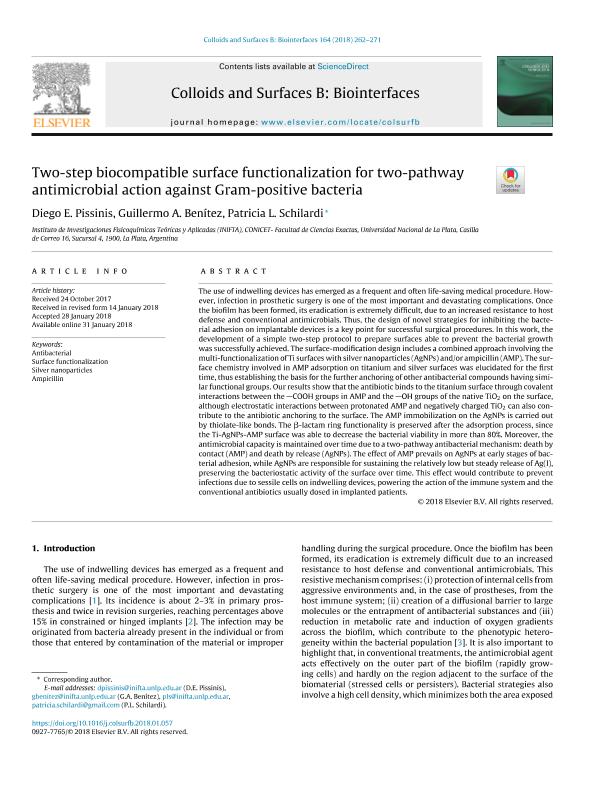Mostrar el registro sencillo del ítem
dc.contributor.author
Pissinis, Diego Ezequiel

dc.contributor.author
Benitez, Guillermo Alfredo

dc.contributor.author
Schilardi, Patricia Laura

dc.date.available
2020-03-18T15:08:06Z
dc.date.issued
2018-04
dc.identifier.citation
Pissinis, Diego Ezequiel; Benitez, Guillermo Alfredo; Schilardi, Patricia Laura; Two-step biocompatible surface functionalization for two-pathway antimicrobial action against Gram-positive bacteria; Elsevier Science; Colloids and Surfaces B: Biointerfaces; 164; 4-2018; 262-271
dc.identifier.issn
0927-7765
dc.identifier.uri
http://hdl.handle.net/11336/100008
dc.description.abstract
The use of indwelling devices has emerged as a frequent and often life-saving medical procedure. However, infection in prosthetic surgery is one of the most important and devastating complications. Once the biofilm has been formed, its eradication is extremely difficult, due to an increased resistance to host defense and conventional antimicrobials. Thus, the design of novel strategies for inhibiting the bacterial adhesion on implantable devices is a key point for successful surgical procedures. In this work, the development of a simple two-step protocol to prepare surfaces able to prevent the bacterial growth was successfully achieved. The surface-modification design includes a combined approach involving the multi-functionalization of Ti surfaces with silver nanoparticles (AgNPs) and/or ampicillin (AMP). The surface chemistry involved in AMP adsorption on titanium and silver surfaces was elucidated for the first time, thus establishing the basis for the further anchoring of other antibacterial compounds having similar functional groups. Our results show that the antibiotic binds to the titanium surface through covalent interactions between the –COOH groups in AMP and the –OH groups of the native TiO2 on the surface, although electrostatic interactions between protonated AMP and negatively charged TiO2 can also contribute to the antibiotic anchoring to the surface. The AMP immobilization on the AgNPs is carried out by thiolate-like bonds. The β-lactam ring functionality is preserved after the adsorption process, since the Ti-AgNPs-AMP surface was able to decrease the bacterial viability in more than 80%. Moreover, the antimicrobial capacity is maintained over time due to a two-pathway antibacterial mechanism: death by contact (AMP) and death by release (AgNPs). The effect of AMP prevails on AgNPs at early stages of bacterial adhesion, while AgNPs are responsible for sustaining the relatively low but steady release of Ag(I), preserving the bacteriostatic activity of the surface over time. This effect would contribute to prevent infections due to sessile cells on indwelling devices, powering the action of the immune system and the conventional antibiotics usually dosed in implanted patients.
dc.format
application/pdf
dc.language.iso
eng
dc.publisher
Elsevier Science

dc.rights
info:eu-repo/semantics/openAccess
dc.rights.uri
https://creativecommons.org/licenses/by-nc-sa/2.5/ar/
dc.subject
AMPICILLIN
dc.subject
ANTIBACTERIAL
dc.subject
SILVER NANOPARTICLES
dc.subject
SURFACE FUNCTIONALIZATION
dc.subject.classification
Físico-Química, Ciencia de los Polímeros, Electroquímica

dc.subject.classification
Ciencias Químicas

dc.subject.classification
CIENCIAS NATURALES Y EXACTAS

dc.title
Two-step biocompatible surface functionalization for two-pathway antimicrobial action against Gram-positive bacteria
dc.type
info:eu-repo/semantics/article
dc.type
info:ar-repo/semantics/artículo
dc.type
info:eu-repo/semantics/publishedVersion
dc.date.updated
2020-03-16T14:00:31Z
dc.journal.volume
164
dc.journal.pagination
262-271
dc.journal.pais
Países Bajos

dc.journal.ciudad
Amsterdam
dc.description.fil
Fil: Pissinis, Diego Ezequiel. Consejo Nacional de Investigaciones Científicas y Técnicas. Centro Científico Tecnológico Conicet - La Plata. Instituto de Investigaciones Fisicoquímicas Teóricas y Aplicadas. Universidad Nacional de La Plata. Facultad de Ciencias Exactas. Instituto de Investigaciones Fisicoquímicas Teóricas y Aplicadas; Argentina
dc.description.fil
Fil: Benitez, Guillermo Alfredo. Consejo Nacional de Investigaciones Científicas y Técnicas. Centro Científico Tecnológico Conicet - La Plata. Instituto de Investigaciones Fisicoquímicas Teóricas y Aplicadas. Universidad Nacional de La Plata. Facultad de Ciencias Exactas. Instituto de Investigaciones Fisicoquímicas Teóricas y Aplicadas; Argentina
dc.description.fil
Fil: Schilardi, Patricia Laura. Consejo Nacional de Investigaciones Científicas y Técnicas. Centro Científico Tecnológico Conicet - La Plata. Instituto de Investigaciones Fisicoquímicas Teóricas y Aplicadas. Universidad Nacional de La Plata. Facultad de Ciencias Exactas. Instituto de Investigaciones Fisicoquímicas Teóricas y Aplicadas; Argentina
dc.journal.title
Colloids and Surfaces B: Biointerfaces

dc.relation.alternativeid
info:eu-repo/semantics/altIdentifier/url/https://www.sciencedirect.com/science/article/abs/pii/S0927776518300651
dc.relation.alternativeid
info:eu-repo/semantics/altIdentifier/doi/http://dx.doi.org/10.1016/j.colsurfb.2018.01.057
Archivos asociados
